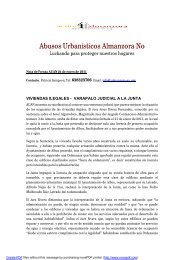European Property Rights and Wrongs - Diana Wallis MEP
European Property Rights and Wrongs - Diana Wallis MEP
European Property Rights and Wrongs - Diana Wallis MEP
Create successful ePaper yourself
Turn your PDF publications into a flip-book with our unique Google optimized e-Paper software.
Given the enormous divergence between property law traditions in Europe<br />
(common law, civil law in its various forms, mixed legal systems), positive integration<br />
(e.g. EU regulations <strong>and</strong> directives) in this area is relatively limited. Examples<br />
are the Insolvency Regulation <strong>and</strong> the Financial Collateral Directive. 32 The impact<br />
of negative integration (a national legal provision is considered to be in violation<br />
of EU law, particularly any of the freedoms of persons, services, goods <strong>and</strong> capital)<br />
is therefore, at least potentially, more far reaching. Examples are cases concerning<br />
public law limitations on acquisition of (second) homes in Austria. 33 Negative<br />
integration also results from the collision between property law <strong>and</strong> fundamental<br />
human rights. The case law developed by the <strong>European</strong> Court of Fundamental<br />
Human <strong>Rights</strong> (ECHR) in Strasburg, interpreting Article 1 of Protocol 1 of the<br />
<strong>European</strong> Convention on Human <strong>Rights</strong> is a striking example of this development.<br />
Case law by the Court of Justice of the <strong>European</strong> Union (CJEU) made it clear that<br />
the protection of fundamental human rights is part of <strong>European</strong> law. 34 The EU<br />
Charter of Fundamental <strong>Rights</strong> reaffirms this <strong>and</strong> it can therefore be no surprise<br />
that the Charter is heavily based on the <strong>European</strong> Convention.<br />
Consequently, it can be concluded that, although it appears that in daily practice<br />
most parts of property law are still purely national <strong>and</strong> that only some areas<br />
have become <strong>European</strong> through positive integration, it could be said that a grey<br />
or mixed area exists between, on the one h<strong>and</strong>, purely national law <strong>and</strong>, on the<br />
other h<strong>and</strong>, <strong>European</strong> law. National property law, not yet replaced as a result of<br />
the positive EU integration process, can only function within the limits set by the<br />
negative EU integration process. It is particularly this grey or mixed area, in which<br />
the debate on the impact of the EU Charter takes place.<br />
From this it follows that 1) the EU has the competence to act in the area of<br />
property law, 2) national property law is affected not only by positive, but also by<br />
negative EU integration (the four freedoms <strong>and</strong> fundamental human rights) <strong>and</strong><br />
32 Council Regulation on insolvency proceedings (EC) No 1346/2000 of 29 May 2000, OJ<br />
30.06.2000, L 160/1 <strong>and</strong> Directive 2002/47/EC of the <strong>European</strong> Parliament <strong>and</strong> of the<br />
Council of 6 June 2002 on financial collateral arrangements OJ 27.6.2002, L 168, 43<br />
(as later amended).<br />
33 Case C-302/97 (Konle) [1999] ECR I-3099 <strong>and</strong> joined cases C-515/99, C-519/99 to<br />
C-524/99 <strong>and</strong> C-526/99 to C-540/99 (Reisch <strong>and</strong> Others) [2002] ECR I-2157.<br />
34 Case 44/79 (Hauer) 13 December 1979, ECR [1979] 3727.<br />
45



